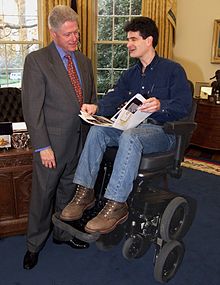This article needs to be updated. (April 2024) |

| This article is part of a series on the |
| Science and technology of the United States of America |
|---|
 |
| Timeline |
| Development |
A timeline of United States inventions (after 1991) encompasses the ingenuity and innovative advancements of the United States within a historical context, dating from the Contemporary era to the present day, which have been achieved by inventors who are either native-born or naturalized citizens of the United States. Patent protection secures a person's right to his or her first-to-invent claim of the original invention in question, highlighted in Article I, Section 8, Clause 8 of the United States Constitution which gives the following enumerated power to the United States Congress:
To promote the Progress of Science and useful Arts, by securing for limited Times to Authors and Inventors the exclusive Right to their respective Writings and Discoveries.
In 1641, the first patent in North America was issued to Samuel Winslow by the General Court of Massachusetts for a new method of making salt.[1][2][3] On April 10, 1790, President George Washington signed the Patent Act of 1790 (1 Stat. 109) into law which proclaimed that patents were to be authorized for "any useful art, manufacture, engine, machine, or device, or any improvement therein not before known or used."[4] On July 31, 1790, Samuel Hopkins of Pittsford, Vermont became the first person in the United States to file and to be granted a patent for an improved method of "Making Pot and Pearl Ashes."[5] The Patent Act of 1836 (Ch. 357, 5 Stat. 117) further clarified United States patent law to the extent of establishing a patent office where patent applications are filed, processed, and granted, contingent upon the language and scope of the claimant's invention, for a patent term of 14 years with an extension of up to an additional 7 years.[4] However, the Uruguay Round Agreements Act of 1994 (URAA) changed the patent term in the United States to a total of 20 years, effective for patent applications filed on or after June 8, 1995, thus bringing United States patent law further into conformity with international patent law.[6] The modern-day provisions of the law applied to inventions are laid out in Title 35 of the United States Code (Ch. 950, sec. 1, 66 Stat. 792).
From 1836 to 2011, the United States Patent and Trademark Office (USPTO) has granted a total of 7,861,317 patents[7] relating to several well-known inventions appearing throughout the timeline below.
- ^ "History of Patent Law". IP Legal Services. August 29, 2021.
- ^ James W. Cortada, "Rise of the knowledge worker, Volume 8 of Resources for the knowledge-based economy", Knowledge Reader Series, Butterworth-Heinemann, 1998, p. 141, ISBN 0-7506-7058-4, ISBN 978-0-7506-7058-6.
- ^ "Manufactures of the United States in 1860; compiled from the original returns of the eighth census, under the direction of the Secretary of the interior", Publisher: Government Printing Office, Washington, 1865, p. cxcix: "Salt-making was commenced at Salein in 1636, and in 1641 Samuel Winslow was allowed, for 10 years, the exclusive right of making salt in Massachusetts by a new method."
- ^ a b "Chapter 4: An Overview of Patents". Digital Law Online.
- ^ "First U.S. Patent Issued Today in 1790". United States Patent and Trademark Office. May 2024.
- ^ "2701 Patent Term [R-2]". United States Patent and Trademark Office.
- ^ "Table of Issue Years and Patent Numbers, for Selected Document Types Issued Since 1836". United States Patent and Trademark Office.
© MMXXIII Rich X Search. We shall prevail. All rights reserved. Rich X Search
